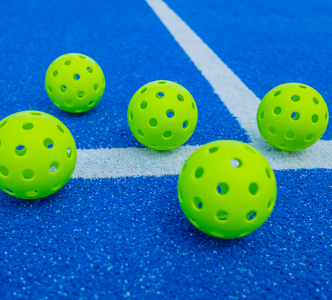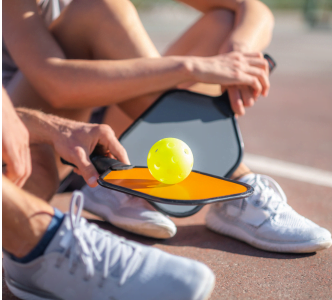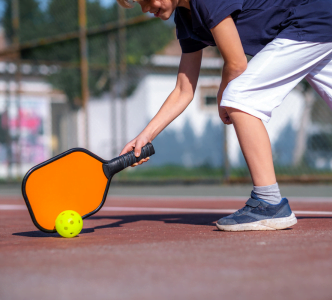Pickleball paddles are the unsung heroes of the court, crucial for every serve, volley, and smash. But here’s a splash of curiosity – can these paddles withstand a dunk in the drink? It’s a question floated around more than a pickleball on a windy day. Are pickleball paddles waterproof? Let’s dive in and soak up the answer.
Materials Used in Pickleball Paddles
Diving deeper into the world of pickleball paddles, let’s break down what they’re made of. It’s not just about looking good on the court, it’s what’s inside that counts.
First up, graphite. It’s the sleek, speedy jet of the paddle world. Graphite paddles are light, letting you move like a pickleball ninja. They’re strong, too, but here’s the catch – they’re like that friend who doesn’t like jumping into the pool. Graphite can handle a sprinkle, but don’t let it take a swim.
Then, we’ve got composite paddles. These are the all-rounders, made from a mix that often includes fiberglass. They hit a sweet spot between power and control. And when it comes to water, they’re a bit like that friend who’ll dip their toes in but won’t dive headfirst.
Wooden paddles are the old-school classics. Depending on your game, they’re heavier, which can be a plus or minus, But water? Wood and water go way back, but not in a good way. Think of wooden paddles as that friend who just wants to sunbathe. Keep them dry, and they’ll serve you well.
How Pickleball Paddles Are Made?
How these paddles are put together is a tale of craftsmanship and technology. The process involves layering materials, pressing them into shape, and then adding the finishing touches. But what about keeping them dry? Some paddles get a waterproof coating, a bit like a raincoat. It helps, but it’s not a magic shield.
So, are pickleball paddles waterproof? They’re more water-resistant than waterproof. Like us, they prefer sunny days to rainy ones. Keep them dry, and they’ll keep you playing.
The Truth About Pickleball Paddles Waterproof and Resistance
Let’s get our feet wet with the truth about water resistance, shall we? When we talk about pickleball paddles, “waterproof” and “water-resistant” are terms that often splash around. But there’s a difference. Waterproof means it can take a dive and come out unscathed. Water-resistant? It can handle a sprinkle but not a swim.
Different materials react to water in their own way. Graphite and composite materials might shrug off a few drops, but let them soak, and you’ll see a different story. Wood, on the other hand, really drinks it in, which can lead to warping or damage over time.
So, what does this mean for the lifespan of your paddle? If it’s constantly getting wet, think of it as adding miles to a car. It’ll start showing its age sooner. A paddle that’s kept dry and cared for can be like that vintage car in the garage: it stays in top shape for the game.
How to Protect Your Pickleball Paddle?
Caught in the rain with your paddle? No worries, let’s talk about keeping it in tip-top shape. First off, if your paddle gets wet, don’t just let it air dry. Wipe it down with a soft, dry cloth to remove moisture. This simple step can be a game-changer.
For drying, avoid direct heat like hairdryers or radiators. They can do more harm than good. Instead, let it dry naturally in a well-ventilated area. Think of it as letting it catch its breath after a long match.
Storage is key. Keep your paddle in a cool, dry place away from direct sunlight. Sunlight is like kryptonite to paddles, causing materials to degrade over time. A closet or a drawer works wonders.
Now, for the long haul, regular maintenance is your best friend. Give your paddle a gentle wipe after each game to keep it clean. This isn’t just about looks; it’s about preserving the surface for optimal play.
And don’t forget about protective gear. A paddle cover or case isn’t just for show; it’s a shield against the elements. It keeps your paddle safe from scratches, dust, and yes, water. Think of it as a cosy blanket for your paddle.
How to Play Pickleball in Wet Conditions
When the clouds roll in but your pickleball game must go on, a few tweaks can keep the fun flowing, rain or shine. First up, gear matters. Opt for a paddle with a good grip to prevent it from slipping out of your hand. Water-resistant paddles might not be fully waterproof, but they’re your best bet in a drizzle.
Next, consider the ball. Water can weigh down a standard ball, so if possible, choose one designed for wet conditions. These balls are made to resist water absorption, ensuring a more consistent play even when it’s pouring.
Adjusting your play style is also crucial. Rain changes the game’s dynamics, making surfaces slippery and balls unpredictable. Slow down your pace, focus on control over power, and anticipate the ball’s movement more cautiously. It’s like dancing in the rain – you need to be a bit more careful, but the joy of the game remains.
Lastly, safety first. Wet courts can be slippery, so wear shoes with good traction. It’s all about enjoying the game without taking a tumble.
How to Choose a Water-Resistant Paddle
Features to Look For
Material Matters: Look for paddles made from materials known for their water resistance, such as composite or graphite. These materials stand up better to moisture and maintain their integrity and performance over time.
Grip That Sticks: A good grip is your best friend in damp conditions. Seek out paddles with moisture-wicking grips or those designed for superior hold, so your paddle doesn’t slip at the crucial moment.
Edge Guard: A robust edge guard isn’t just for show; it protects your paddle from dings and moisture ingress along the sides. This small feature can significantly extend the life of your paddle.
Weight and Balance: While not directly related to water resistance, a paddle that feels right in your hand will enhance your control and confidence, even in wet conditions.
Before choosing a pickleball paddle read the USA pickleball equipment rule to consider the legal pickleball paddle for your play.
Recommended Brands and Models
Selkirk Amped Series: Known for their innovative X5 Core, which provides outstanding performance and durability, Selkirk paddles are a solid choice. Their moisture-resistant design and comfortable grip make them a favorite among players.
Paddletek Tempest Wave Pro: Featuring a composite core and textured graphite surface, this paddle offers excellent control and is less prone to water damage. Its well-designed grip ensures the paddle stays in your hand, no matter the weather.
Onix Evoke Premier: Designed with input from top players, the Evoke Premier uses advanced materials that hold up well in damp conditions. Its exceptional balance between power and control makes it a versatile choice.
Gamma Legend NeuCore: With a thick Neucore poly core, this paddle is designed for a soft, responsive feel that performs well in all weather. The textured composite face adds to its durability and water resistance.
Many pickleball enthusiasts add texture to their pickleball paddles to enhance grip and control during play. This modification helps improve spin and precision on shots.
When shopping for a water-resistant paddle, remember that while no paddle is entirely waterproof, choosing one with these features and from a reputable brand can significantly improve your experience on wet days. Always pair your choice with proper care and maintenance to ensure your paddle remains in top condition, rain or shine.
Conclusion
navigating the challenges of wet conditions in pickleball requires understanding the nuances between water-resistant and waterproof paddles and selecting the right materials for durability.
This guide has offered essential tips on how to care for your paddle when it gets wet, from effective drying methods to proper storage, ensuring its longevity. It also provided strategies for adapting your play in rainy weather and highlighted the importance of using suitable equipment.
By following the advice outlined, players can protect their paddles from water damage and continue to enjoy their game, regardless of the weather.
FAQ’s
Can I play pickleball in the rain?
Yes, playing pickleball in the rain is possible, but caution is key. The wet conditions can impact how well you grip your paddle and the way the ball moves. To stay safe and maintain performance, choose a water-resistant paddle and shoes that provide solid traction.
How do I know if my paddle is water-resistant?
To determine if your paddle is water-resistant, review its specifications. Look for mentions of water-resistant materials such as graphite or composite in its construction. Features like moisture-wicking grips and edge guards are also good indicators. If unsure, reading product reviews or contacting the manufacturer can offer clarity.
Will water ruin my pickleball paddle?
Water isn’t likely to immediately damage most paddles, but regular or long-term exposure could be harmful, particularly for wooden paddles or those made from less durable materials. The structure and grip of your paddle, as well as its performance, could degrade over time due to water exposure.
How do I dry my pickleball paddle properly?
If your paddle becomes wet, the best approach is to gently pat it dry with a soft, absorbent cloth, avoiding any harsh rubbing. Steer clear of direct heat sources, such as hair dryers, which could harm the paddle’s material. Allow it to air dry in an area with good airflow, away from the sun. Should the grip become wet, removing it to dry or replacing it might be necessary if it shows significant wear.







